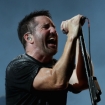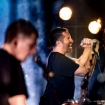If you grew up in the Nineties wearing all black and romanticizing all things morbid, chances are you were seriously into The Crow. Sadly, the 1994 supernatural thriller doesn't hold up as well as we would have hoped — but, man, its soundtrack. When it comes to its unfuckwithable legacy, we have only one real question: great soundtrack or the greatest soundtrack?
Featuring the Cure, Nine Inch Nails (covering Joy Divison), My Life With the Thrill Kill Kult and Machines of Loving Grace, The Crow easily could have been an industrial-goth counterpart to the Singles soundtrack, which was released just the year before and curated its tracklist mostly from the ascendant Seattle grunge scene. But no, The Crow soundtrack may be consistently dark but it's also impressively diverse. Burly hardcore/metal? Check, thanks to Pantera covering Poison Idea, Rollins Band covering Suicide, Rage Against the Machine covering their goddamn younger selves — oh yeah, and Helmet doing their punchy, staccato thing. Grungy hard rock? Check, thanks to Stone Temple Pilots and For Love Not Lisa. Shoegazing dream-pop? Check, thanks to Medicine assisted by the Cocteau Twins. Swaggering noise-pop? Check, thanks to the Jesus and Mary Chain. Dreary acoustic rock? Check, an unlikely thanks to Violent Femmes. Soaring bittersweet balladry? Check, thanks to Canadian singer-songwriter Jane Siberry.
Below, we look back at the soundtrack of The Crow — and the soundtrack of our lives — with 14 little-known facts about its 14 timeless cuts.
1. The Cure's "Burn" was recorded by just the band's frontman Robert Smith and drummer Boris Williams
As the story goes, the Cure were originally going to contribute their devastating Pornography cut "The Hanging Garden" to The Crow soundtrack since the lyrics to the song had been appeared in the original comic book, but Robert Smith liked the comic so much that he opted to write and record an original song instead. He did so quickly: The Cure's lineup was in flux at the time, so Smith and drummer Boris Williams turned around their contribution, "Burn," on their own over the course of just two days, as Smith told Radio 104.5 in 2008. "I had the idea, and we just recorded it, me and him, in the studio," the singer says. Interesting, the song was also the last thing that Smith and Williams ever put on wax together; the drummer split shortly thereafter.
2. Machines of Loving Grace read the screenplay of The Crow before writing "Golgotha Tenement Blues" and created the song to fit the film
Like the Cure, Arizona-based industrial-rock band Machines of Loving Grace also composed an original song specifically for the soundtrack — and they got a serious leg up on the undertaking. "We were very lucky in the sense that we were involved with that project very early on," keyboardist/programmer Mike Fisher said in a 1996 interview. "I think we were actually the first band approached to be on that soundtrack, and we were familiar with the director and the comic, and we actually got to see the screenplay a year before the thing was even filmed, so we had a pretty good sense going into it what the film was going to be like. We tried to sort of match the mood." As fans of the band know, "Golgotha Tenement Blues" doesn't sound like any of their other songs; according to Fisher, this is why.
3. Stone Temple Pilots originally planned to contribute a different song than "Big Empty" to the soundtrack, but switched gears after Brandon Lee's death
Stone Temple Pilots were initially set to appear on The Crow soundtrack via a song called "Only Dying." The band had demoed it early in its career, but would never officially released it — until 2017, on the 25th-anniversary box-set reissue of their debut album, Core. STP changed their plans after Crow star Brandon Lee was killed in an on-set accident, deciding that "a darkly satiric song mocking death," as producer Jeff Most described "Only Dying" to MTV.com in 2009, would be in poor taste. "We wrote it maybe nine months after Dean [DeLeo, STP guitarist] joined the band," drummer Eric Kretz told Rolling Stone, "and we recorded it in a studio in north Hollywood before we got signed." "I remember Scott [Weiland] really wanted to redo the song and quite honestly, the guitar tone we chose on that ... I don't know what I was thinking," DeLeo said. "Maybe I was listening to too much Robert Smith or something. It's a song where I don't think we reached our full potential as songwriters quite yet. But honestly, it really is a beautiful song."
4. Nine Inch Nails' Joy Division cover ("Dead Souls") is a Crow soundtrack standout, but according to Peter Hook, the former members of Joy Division were originally asked to cover the band
If Peter Hook — the founding bassist of both Joy Division and New Order — is to be believed, the latter band was offered a spot on The Crow soundtrack, with the idea being that they would pay homage to their former group. (Joy Division was Crow creator James O'Barr's favorite band and a key inspiration to his comic book.) "The producer asked us to record [Joy Division's] 'Love Will Tear Us Apart,' as New Order," Hook revealed in a 2013 interview while promoting his book Unknown Pleasures. It didn't end up panning out, of course, and the bassist has given his seal of approval to Joy Division's ultimate appearance on the soundtrack, in the form of Nine Inch Nails' cover. "I like the band a lot, but they did the song very faithfully," he commented. "It's a real complimentary interpretation of 'Dead Souls.' A lot of the time when I hear it, I think it's us. That's a great compliment from Trent [Reznor]." For his part, Reznor was a fan of the Crow comics before the movie was even in production and NIN's Joy Division cover was the first song he recorded in the Sharon Tate house, where he had set up for the Downward Spiral sessions.
5. Rage Against the Machine's "Darkness" dates back to Zack de la Rocha's pre-RATM band Inside Out
Before Zack de la Rocha, Tom Morello, Tim Commerford and Brad Wilk reworked and re-recorded it for The Crow soundtrack, Rage Against the Machine's scathing, seething cut "Darkness" was known as "Darkness of Greed" and appeared on the L.A. political firebrands' 1991 demo tape. But even before that, it was played live in a rawer, more uptempo form by de la Rocha's O.C. hardcore-punk band Inside Out. The group had written material for a new album, to be titled (surprise, surprise) Rage Against the Machine, before breaking up in mid-1991 when guitarist Vic DiCara (later of the band 108) split to become a Hare Krishna monk.
6. Violent Femmes had written "Color Me Once" before they were asked to contribute in The Crow soundtrack, but based on what they heard about the movie, they thought it would fit
As fans know, the Violent Femme's "Color Me Once" represents a significant change of pace for the band, better known for their quirky up-tempo acoustic rockers such as "Blister in the Sun." Bassist Brian Ritchie described the song — not inaccurately — as an "ethereal sort of musical extravaganza" to MTV's Alternative Nation, one that the group had written before they had even heard about The Crow soundtrack. When they were finally offered a slot on said soundtrack, "Color Me Once" came to mind as a fitting inclusion; they send it to the producers and, according to Ritchie, "We must have it, we can't live without it. And the rest is history."
7. The song "Ghost Rider" is based on the Marvel comic-book character, but Henry Rollins was not a fan of the "motorcycle hero ... blazin' away"
Henry Rollins first recorded "Ghost Rider" for his 1987 solo album Hot Animal Machine, but he was drawn to the song not out of some love for the skull-headed Marvel superhero, but because of his deep fandom for the protopunk band Suicide (singer Alan Vega and keyboardist Martin Rev), which wrote and recorded the song in 1977. The NYC group's original is a pulsing, whispery cut that's a far cry from the Jim Morrison-does-sludgy-blues-metal rendition heard on The Crow soundtrack. Marvel.com once asked Rollins about the cover in reference to the superhero: "Were you a fan of Ghost Rider or just the song or what?" To which the former Black Flag frontman responded, "I was raised on the first Suicide album and the singer Alan Vega is a very longtime pal of mine and so it was basically just a tribute to Alan and Marty [Rev], the two guys in Suicide. I'm not very familiar with the actual comic book character," the singer said, likely to the disappointment of his interviewer, "outside of I know that he's very angry."
8. Helmet's "Milktoast" is an alternate version of the band's "Milquetoast" recorded with Nevermind producer Butch Vig, who played a big part in the outcome of both versions
Before the song appeared on Helmet's Andy Wallace-produced 1994 album Betty, "Milktoast" or "Milquetoast" was unleashed in a more distorted and industrialized form on The Crow soundtrack; this take was helmed by Butch Vig, best known for his work on a little album called Nevermind and, later, for playing in a band called Garbage. "I had wanted to work with Butch before but I was wary because of the whole Nirvana thing," Helmet main man Page Hamilton told Rolling Stone. "Record companies wanted everything Nirvana but we weren't Nirvana. But I met him and really liked him." Vig had suggestions for the song, and these ended up influencing both The Crow and Betty versions. "Butch gave me the idea to have no guitars on the first verse," Hamilton revealed. "Like, 'Why don't you mute the guitars here and just do this vocal thing?' And then he added that Pink Floyd, A.M-radio effect to my voice. That all changed the feel of the song, because originally it was in-your-face right from the beginning. Which is kind of our thing — Helmet's not really known for dynamics. But Butch was like, 'How about some dynamics?' And I said, 'What a great idea!' It turned out to be one of my favorite things on the album."
9. Pantera not only paid tribute to hardcore crew Poison Idea with their cover of "The Badge," but they also took influence from the group on Far Beyond Driven
Pantera singer Phil Anselmo has been a longtime fan of hardcore music, and when asked by ARTISTdirect.com what was inspiring him in 1993 during the making of the band's chart-topping album Far Beyond Driven, he pointed to the likes of Black Flag, Agnostic Front and, of course, Oregon miscreants Poison Idea. "Poison Idea's Pick Your King record was really balls-out, one-take hardcore that fucking delivered," Anselmo enthused. "I'm a frigging music nerd, dude! I wear that shit on my sleeve. I think everybody knows that. Any influence I could fucking take from ..." When it came time to contribute a track for The Crow soundtrack, Pantera pulled from another Poison Idea record, however — 1990's Feel the Darkness — for a crushing rendition of the album's "The Badge." (The cover also appeared as a bonus cut on the Japanese edition of Far Beyond Driven and on a 2014 Record Store Day vinyl split with Pantera.) And the inspiration didn't stop there: Anselmo would continue to pay homage to the band with hardcore-inflected projects such as Superjoint Ritual and Arson Anthem.
10. For Love Not Lisa were initially reluctant to be part of The Crow soundtrack because they thought it was going to be "crappy kung-fu movie"
Oklahoma hard-rock outfit For Love Not Lisa would come to look back on the inclusion of their song "Slip Slide Melting" on The Crow soundtrack as "the highlight of our band's entire career," according to vocalist Mike Lewis, but the group's initial read on the film and their part in it was very different. "We knew it was a Brandon Lee movie and that our song would be in it," Lewis recalled to MTV.com. "We were thinking, 'OK, crappy kung-fu movie nobody will ever see.' But after we saw some of the storyboards, we were like, 'Wow, this movie is like a dark version of Batman.' We pulled over on tour and called our managers and were like, 'We have to be on this thing!'"
11. My Life With the Thrill Kill Kult shot their brief but memorable cameo in The Crow, playing their song "After the Flesh" "10 thousand times" in a freezing cold abandoned cement factory over two days
Making movies is not as glamorous as it might seem from the outside. Take for instance My Life With the Thrill Kill Kult's appearance in The Crow: The Chicagoan industrial-disco sleaze-rock outfit filmed their cameo over two days of extremely harsh conditions. "We did it in a cement factory and it was, like, minus 20 degrees outside," founding member Buzz McCoy recalled the experience to Rock N Roll Junkie: "It was an abandoned cement factory and it was really, I would say, it was about 20 degrees in there because it was cold and damp because it was so cold outside," he said. "We were, literally, freezing with leather and everything on. They had one room that had a heater in it that was for us, but all the kids in the audience that were shirtless and stuff were freezing. They were shivering in blankets for hours and then they'd get up and dance and then they'd go lay down and shiver in blankets and we did it for two days." Adding to the punishment, McCoy said they played the song about "10 thousand times." "We'd do like half a verse and then, 'Cut!' and we'd sit around for two hours and then, 'OK, do it again!' and then do another half a song and then wait for three hours."
12. Despite being released on the Jesus and Mary Chains' The Sound of Speed compilation months before its appearance on The Crow soundtrack, "Snakedriver" was written for the movie
U.K. noise-pop troubadours the Jesus and Mary Chain first dropped their now-classic single "Snakedriver" on the world in 1993, via a July compilation of singles and rare tracks called The Sound of Speed — eight months before the March '94 release of The Crow soundtrack. Which might lead one to think that the song was picked up after the fact for the film. According to a brief '93 interview with the band on MTV's Alternative Nation, that was not the case, however. "[The producers] had asked us for a song, and we went into our studio, messed around with a couple possible ideas," the band's Jim Reid says in the clip. "This one worked out the best." Indeed it did, lyrics of "syphilitic hetero friends" and fading "photographs of god" and all.
13. Medicine's "Time Baby III" features the Cocteau Twins' Elizabeth Fraser and is titled "III" because there are, in fact, three versions of the song
If you thought the song that L.A shoegaze outfit Medicine plays onscreen in The Crow sounds different than their contribution to the soundtrack, that's because it is. In the movie, they're playing "Time Baby II," off the band's 1993 EP 5ive; the track on the soundtrack is a harsher, more unpolished version of the song remixed by the Cocteau Twins' Robin Guthrie, with additional vocals from the gothy dream-pop group's lead singer, Elizabeth Fraser. As for the original "Time Baby," that's an early Medicine demo, around two minutes longer than "II" and "III," that was recorded before the band's frontwoman Beth Thompson joined on; hear it below.
14. Jane Siberry's "It Can't Rain All the Time" was co-written by Graeme Revell, who scored the movie and was also the mainstay member of Eighties industrial outfit SPK
"It Can't Rain All the Time," which in the movie is a song written by The Crow's protagonist Eric Draven, was in real life penned by Canadian singer-songwriter Jane Siberry and composer Graeme Revell, who also scored the film. Revell was a good pick to work on such a definitive gothic-industrial movie as The Crow since he had cut his teeth as a founding member of the seminal New Zealand electronic-noise group SPK, who banged sheet metal and destroyed shit onstage in the same spirit as Einstürzende Neubauten (see below). Eventually making his name in Hollywood, Revell would score movies including Dead Calm, From Dusk Till Dawn and Sin City, as well as assist Evanescence with the string arrangements on their debut album, Fallen.








